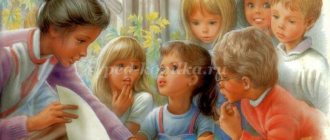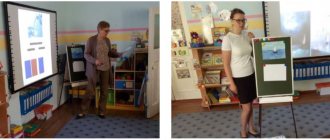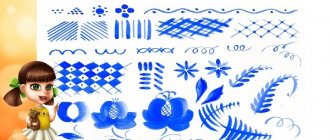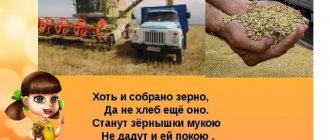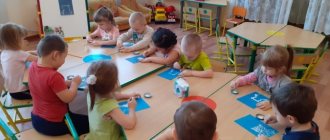Conversation about the forest in the preparatory group
Summary of a conversation about the forest for children 5-7 years old “A Journey through the Rooms of a Green House”
Author: Alevtina Germanovna Korobkina, teacher of the preschool educational institution “Smile” kindergarten, Perm region, urban settlement Suksun. Description: This material can be used by educators, counselors and primary school teachers, as well as parents in environmental education. Goal: to continue to form an understanding of the forest and the forester profession. Objectives: Educational.
Contribute to: clarifying and systematizing ideas about the forest and the forester profession;
strengthening cognitive interest and love for nature; aesthetic perception of the beauty of nature, through reproductions of paintings; Developmental.
Promote: the development of coherent speech, the ability to maintain a conversation, answer questions with complete answers;
developing respect for the work activity of a person in the forester profession; development of thinking, attention, memory. Educational.
Promote: nurturing love and respect for nature.
Material: reproductions of paintings by artists: Shishkin “In the Forest of Countess Mordvinova”, Shishkin “Ship Grove”, Levitan “Birch Grove” Illustrations on the topic phonogram “Sounds of the Forest” basket of hazelnuts Preliminary work: reading natural history literature to children, looking at reproductions of paintings by artists about nature , reading and memorizing poems on an environmental theme, excursions to the park, pine forest. Organization: children stand in a circle, holding hands. Round dance game “Let's go through the raspberries into the forest” 1. Let's go through the raspberries into the forest, let's go into the forest into the forest (children walk in a circle). Let's start a dance, let's start, let's start (one by one they put their legs out) Chorus: The sun is in the yard (hands are raised up, fingers are open - “sun”) And in the forest there is a path (palms folded together perform wave-like movements in front of you) My sweet you, raspberry ( sliding movements of the palms - the “Skeet” movement) 2. You, raspberry, not in the mouth, not in the mouth, not in the mouth (pinch grip of three fingers of the leading hand, move towards the mouth) Pour into the box, box, box. (a pinch grip of three fingers of the leading hand imitates picking berries into a basket, in front of the chest. Chorus: the movements are the same 3. Like picking, picking, picking raspberries. (a pinch grip of three fingers of the leading hand imitates picking berries from the ground - with the body tilted) We will bake pies, let's bake, let's bake ("pies" movement). Chorus: the movements are the same. 4. We'll bake, bake, bake pies. ("pies" movement). We'll call all the neighbors, we'll call, we'll call (movement of the hands, palms facing the face - “invitation”) Chorus: the movements are the same.
PROGRESS OF THE CONVERSATION.
Educator: What are we up to today? Children: will go on a journey through different rooms. Educator: which rooms can you travel through? Children's answers Educator: the riddle that the poet Jovan Jovanovic came up with will help us - Zmaj, listen carefully! I want to invite us to one beautiful village. He was quite lucky, who was able to visit the din. There, every house and every yard is covered with a green roof, a carpet woven with flowers lies on the street. There are no fences or doors. The windows are open to the garden. Guests will be greeted there with songs and treated to great pleasure. Those who were lucky enough to be there saw miracles! And the unusual village is called... Children: Green Forest Teacher: how did you guess that the riddle is about a forest? The children are talking. Educator: Yes, our journey to the big green house and through its rooms.
Educator: remember what riddle Dunno told us this morning? Zhenya came first today and can repeat, let’s all listen carefully to Zhenya. Zhenya: “a multi-storey building that was not built by a person. With invisible walls and an invisible ceiling. This house has very different apartments. The upper floors are bright and dry. The lower floors are dark and damp. The house has warm apartments in which you can live all year round. There are cold apartments in which you can only live in summer or spring.” Author of the riddle: Ivanova Valentina Tarasovna Educator: why can you call a forest home?! Children: home, because plants and animals cannot live without each other. Educator: Do you know such residents who cannot live without each other in the forest? Children: express and prove their versions, lay out pictures of forest inhabitants connected to each other.
Educator: what are these invisible walls in this house that was not built by man? Children: you can walk through the forest and see different things, there are no walls, but still different. Educator: yes, the forest is very different! The pine trees rustle with dry lingonberry leaves.
Educator: where were we?
Children: In a pine forest. Educator: a pine forest is also called BOR. Let's go further and see an emerald carpet of blueberries.
Now which forest did you enter?
Children: to the coniferous forest. Educator: The coniferous forest is also called BOR. We moved to another room. Did you see the wall? Children: no, we moved from a pine forest to a spruce forest. Educator: yes, different rooms, different forests. Let's move on. The thicket of bushes is impassable. What is that growing there?
Children: raspberries Teacher: let's go further through the forest. We reached the swamp.
The forest has become sparse. We passed the swamp. And suddenly it became light all around. What forest pleases with light and whiteness?
ISAAC ILYICH LEVITAN “BIRCH GROVE” Children: birch forest Teacher: can you name the residents? Children name the forest inhabitants . Teacher: what kind of forest does the brown BEAR like? Children: where there are a lot of berries and a river. Educator: the bear is a predator, but if you eat plant foods, you can do without meat. He’ll catch a fish in the river, that’s enough for him. Because what is it called? Children: omnivore. Educator: well, where does the FOX like to live?
Children: in a hole, digs a hole among the roots. Educator: what are these invisible ceilings, why does the riddle say so?
Educator: what is the first floor? Children: roots underground, mice live, moles. Educator: who lives higher? Children: cuckoos live in the bushes and make nests. And the woodpecker is hollowing out the hollow even higher. A squirrel can make a hollow even higher than a woodpecker. Birds that like to be closer to the sky go higher. Educator: yes, falcon families. Which apartments are dry and bright? Children: those in the trees, squirrels and birds. Educator: Which ones are busy all year round? Children: in the summer, because many birds fly to warm countries for the winter. Educator: who has dark apartments? Bears, foxes, badgers, hedgehogs have children Educator: who guards the forest? Children: forester. Educator: forester, forester, forester. She comes from ancient professions; forests have been protected in Rus' for a long time. More than 150 years ago, a forestry institute was opened in St. Petersburg. Now it is the Forestry Academy, University or Institute
Here in the Urals, the Forestry Engineering University trains foresters who grow forests in all corners of Russia. So, why did people come up with the profession of forest rangers if the forest grows on its own without humans? We will find out if we go to the forestry university and become students of this university
CHILDREN SIT ON CHAIRS, IMITATING A UNIVERSITY AUDIENCE. Educator: Why does a forester guard the forest, and here’s why. What if there's a forest fire? What if a bad man comes with an ax? What if a harmful caterpillar or bug appears? So goodbye forest! And to prevent this from happening at the cordon, the forester goes around. He walks around the forest and is the first to see if a bark beetle appears.
The bark beetle is small, but can eat a large forest. There are so many beetles that they sit on every tree, they sit on every twig, gnawing and sharpening. You can't remove them with your hands. And then the forester calls for help. A plane will fly in and scatter yellow poisonous powder. The bark beetle runs in, but there is no escape, no escape. Educator: So why create a cordon? Children's answers Teacher: if you cut down a forest, then only old trees, and don't touch young trees, then there will be no harm. So they SWEEP the forest, they whip it - that means they are cutting down big old trees. The timber is transported by trucks - timber trucks.
Timber trucks transport long trees with chopped off branches - they are called WHIP. They cut down trees with saws.
When the whips are removed, in the large clearing where very old trees used to grow, only stumps remain. Educator: So, what trees do lumberjacks cut in the forest? Children's answers Teacher: so, how then is the forest restored? Who is planting it? Children: probably the forester? Educator: to confidently answer my question, listen further. And at the cordon - a forest post - near the forester's hut - there are beds! But it’s not tomatoes or cucumbers that grow in the beds. MIRACLE
small, fluffy Christmas trees are growing! When it’s hot, they are watered, and the soil around them is also loosened with a rake. Everything is like in a garden. The soil of the Christmas trees in the beds is black. And the pines have sand. Who loves what! In the spring of this forest nursery, seedlings - very young pines and fir trees - will be brought to the cutting site. Here they will be planted and a new forest will grow.
Educator: Why will the seedlings be brought to the cutting area? Children: because old trees were cut down there. Educator: And in seventy years he will become an adult. Fast or long? Here you are 6, and now you are 7 years old. On the Christmas tree, its age can be easily counted by the rows of paws, as if by steps. Or you can recognize it by the rings on the trunk of a cut tree.
So the most amazing thing is that one person will plant it, and people of another generation will use this tree; probably, it will be possible to say about them that these are the children of your future grandchildren or even great-grandchildren?! The tree grows very slowly. So who knows the GROWTH of the forest?! Children: FORESTRY. Educator : our journey is coming to an end, let's remember the poem by the poet Alexei Koltsov “The Forester's House.” To the soundtrack “Sounds of the Forest,” children recite the poem line by line. In a dark forest, across the river, there is a small house, With two bright windows, With swing gates. That gate is under the castle, And the gate is locked, So that the horned Leshy, terrible and shaggy, does not enter there; So that a ghoul does not enter there, nor a passing hero, who lives here alone, far from housing around? Is the fisherman not rich? Or is there a bearded robber who is saved by prayer with chests and treasury? He has lived in the house for a long time - The forest elder and his wife are on guard in the royal forest. The third daughter is young. Conclusion. Educator: we have returned from a trip through the forest rooms. What did you like best about the trip? Children's answer Teacher: what new did you learn? Children's answer Teacher: the forester handed you a treat, what do you think it could be? Children's answer Teacher: a basket of hazelnuts. Educator: is the forester alone protecting the forest? Children name people of different professions who help the forester. Thank you for your attention!
We recommend watching:
Scenario of summer entertainment for children of the senior preparatory group of a preschool educational institution. Entertainment in the preparatory group. Scenario Conversation with children in the preparatory group on the topic: Wildflowers Summary of summer sports activities in kindergarten for older preschoolers
Similar articles:
Dramatization of Chukovsky's fairy tale The Fly Tsokotukha for children 5-7 years old
Scenario for summer entertainment on ecology at a preschool educational institution. Senior – preparatory group
Disco in kindergarten. Scenario
Game entertainment for children of senior preschool age in kindergarten
Lesson summary “Forest - multi-storey building”
MBDOU No. 5 “Scarlet Flower”, Tikhoretsk, Krasnodar Territory
Educator
Winner (1st degree diploma) of the All-Russian competition for teaching staff of preschool organizations “Best lesson notes in kindergarten”
Link to the article, when indicated in the bibliography (according to GOST R 7.0.5-2008):
Posokhova S.B. Lesson summary “Forest - multi-storey building” // Sovushka. 2015. N1. URL: https://kssovushka.ru/articles/e-sovushka.2015.n1.00010.html (access date: 11.21.2021).
Goal: to clarify and expand children’s ideas about the forest and its inhabitants.
Tasks :
- give children an initial idea that a forest is a multi-storey building in which many plants and animals live on different “floors” (tiers), which find food, places for nests, and burrows in it;
- show the multi-tiered nature of the forest;
- identify and enrich children’s ideas about the importance of forests in human life;
- give children an idea of a forester - a person who takes care of the forest: protects from fire, feeds animals in winter, saves some of them from harm;
- develop children's cognitive interest, respect for nature, and correct behavior;
- to cultivate interest in nature, the ability to see its beauty, the desire to preserve all living things.
Preliminary work:
- conversation about the forest;
- examination of illustrations depicting the forest and the album “Beasts of the Forest”;
- learning proverbs about the forest;
- guessing riddles about forest animals;
- looking at illustrations depicting a forester.
Materials:
- model “floors of the forest”, pictures depicting trees, bushes, mushrooms, berries, forest inhabitants;
- tables; pictures “How a forester takes care of the forest”, “Rules of conduct in the forest”, “Why do people go to the forest.”;
- musical accompaniment.
Methodological techniques : asking riddles, playful actions of placing animals on the floors on the diagram, filling out tables, asking questions to children, assessing and rewarding, listening to musical recordings, viewing slides.
Equipment: multimedia installation, tape recorder.
PROGRESS OF THE CLASS
Educator: Guys, today we will go on a trip in a hot air balloon, and you will find out where along the way (the teacher offers to take the children’s seats). While we are flying, I will tell you a riddle, and you will guess where we will go.
The hero is rich and treats all the children: Vanya with strawberries, Tanya with stone fruits, Mashenka with nuts, Petya with russula, Katenka with raspberries, Hooligan with twigs.
Children : into the forest. Educator: that's right, this is a forest. While you and I are flying into the forest, let's see how many interesting things you can see (view multimedia slides, ask the children how everything looks from above, bring up the fact that from a height everything seems small, only the roofs of houses are visible) Educator : Listen ... Hear the breeze playing with the leaves. But the voices of birds were heard (the voices of birds sound) Do you hear? Xin-xin-xin is the song of a tit, cha-cha-cha is a magpie, chiv-chik-chik-chirik is a sparrow. We are approaching the forest (music sounds). Children, can we say that we heard the voice of the forest? Why? (children's answers) Educator: Now we have arrived in the forest, let's get out of the balloon. Hello, forest, dense forest, full of fairy tales and miracles. Look how many trees, mushrooms, and bushes there are in the forest. How many colors... Red, burgundy color can be found in mushroom caps and ripe lingonberries and cranberries. Yellow and orange colors are given by forest daisies and butterflies. You will find the color green in grass, leaves and mischievous grasshoppers. Blue - in the expanses of heaven and clear waters. The blue color is hidden in forest clearings in cornflowers and bluebells. And the purple color is about to fly away on the wings of a beetle (Slides showing a forest on a multimedia installation are shown). Educator : Who do you think are the most important inhabitants of the forest? Children : trees Educator: That's right, trees. What trees grow in the forest? (slides with images of trees are shown and their names are clarified). Educator: Guys, here are pictures of trees, try to name them (the children name the trees, the teacher asks how they knew that it was birch, oak, spruce, etc.) Educator: What else grows in the forest? (children's answers: bushes, berries, mushrooms, grass...) Educator: Who do you think needs trees, grass, shrubs and mushrooms and why? (children's answers: animals, birds, insects...) Educator: That's right, different animals live in the forest: animals of prey (wolf, fox, bear, lynx), forest birds (magpie, nightingale, owl, woodpecker), insects (ants, beetles) , caterpillars, mosquitoes). Educator: Can a forest be called a multi-story building? (children’s answers) Educator: Let us now create your own forest (a picture of a forest is assembled on the panel) Educator: Now let’s compare the forest with a multi-story building (a table with a picture of a multi-story building is inserted into the table-panel “Forest”, a line is drawn from each floor , passing through the panel) Educator: What grows on the first floor? (children's answers: grass, mushrooms, flowers....) Educator: What grows on the second floor? (children's answers) Educator: That's right, the next floor is occupied by smaller bushes and trees, and the topmost floor is occupied by tall oaks and pines. All floors are inhabited by forest inhabitants. Tell us which forest inhabitants live on which floor? (children's answers) Educator: A forest is like a large multi-story building. There are many, many tenants and neighbors living there. They all need each other (Slide show - multi-tiered forest) Educator: Guys, which of you lives in a multi-story building? (children's answers) Educator: Now you know that not only a house, but also a forest can be multi-story (check with the children what grows and who lives on different floors of the forest) Educator: Do you think a person needs a forest? (children's answers) Educator: The forest is a wonderful natural resource. People go there not only to pick mushrooms and berries, they go to the forest to relax, enjoy the silence, coolness, clean air, birdsong, forest rustles (work with a table - children are offered pictures, from which they need to choose those that show why a person goes to the forest Children choose pictures and paste them into the table) Educator: Children, do you think the forest can be offended? (children's answers) Educator: A plaintive book of the forest fell into my hands. (children look at a book of complaints, the teacher reads out complaints from flowers, birds, etc.) Educator: How can you help the forest? (children's answers) There are pictures on the table depicting what should not be done and how you can help. Educator: I have prepared 2 tables for you: on one the flower is smiling, and on the other it is sad. Why do you think? (children's answers: the flower is sad - this should not be done in the forest, smiles - how can we help the forest). Educator: Let's choose pictures for ourselves and fill out the tables. (Children fill out a table about the rules of conduct in the forest) Educator: Well done! Remember these rules and follow them. Guys, we told you that the forest is a big house. Every house has an owner. Do you know who is the main owner in the forest? (children's answers) Educator: That's right, the main person in the forest is the forester. He knows all the inhabitants of the forest well and tries to help them in difficult times. He makes sure that the trees do not get sick, extinguishes forest fires and plants new trees to replace those cut down. There are not so many foresters in our country; the work of a forester is difficult and sometimes dangerous. He lives in the forest far from the city. Let's see how a forester takes care of the forest (look at the table). Educator: Guys, think about whether ordinary people can help the forest and forest inhabitants? How? (children's answers) Educator: Well done. You and I talked a lot about the forest, its inhabitants, the rules of behavior in the forest, the necessity of the forest for people, and the work of a forester. And now it’s time for us to say goodbye to the forest:
Dense forest, goodbye! You will grow to the joy of people! We will be friends with you, kind forest, mighty forest, Full of fairy tales and miracles!
Educator: Let's get into our balloon and go back to kindergarten (children take their seats). Educator: In the meantime, tell me why the forest is called dense and mighty? (children’s answers) Educator: What does it mean “you will grow up to please people”? Educator: Why do you think the forest is full of fairy tales and miracles? (children’s answers) Educator: You and I didn’t notice how we arrived (children get out of the balloon). We are back in kindergarten. Educator: Did you like our trip? What did you like most? (children's answers) Educator: Now you know that a forest is a multi-story building in which many plants and animals live on different “floors” and find food, places for nests, and burrows in it. You know the rules of behavior in the forest and that the main person in the forest is the forester.
Summary of the conversation for the preparatory group “Journey to the Autumn Forest”
Summary of the conversation for the preparatory group “Journey to the Autumn Forest”
Target:
systematization of knowledge about the signs of autumn.
Tasks:
Educational:
– cultivate responsiveness and love for nature.
Educational:
– develop visual-figurative thinking, the ability to draw conclusions, substantiate one’s judgments, the ability to work in a team, and interact;
– develop fantasy and imagination.
Educational:
– expand and generalize children’s ideas about autumn, forest, trees, forest inhabitants;
– to form methods of mental action: analysis, synthesis, comparison, generalization, exclusion.
Materials and equipment for the conversation:
illustrations on the topic of conversation. Tree leaves. Visual
